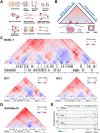KSHV Topologically Associating Domains in Latent and Reactivated Viral Chromatin
- PMID: 35867573
- PMCID: PMC9327698
- DOI: 10.1128/jvi.00565-22
KSHV Topologically Associating Domains in Latent and Reactivated Viral Chromatin
Abstract
Eukaryotic genomes are structurally organized via the formation of multiple loops that create gene expression regulatory units called topologically associating domains (TADs). Here we revealed the KSHV TAD structure at 500 bp resolution and constructed a 3D KSHV genomic structural model with 2 kb binning. The latent KSHV genome formed very similar genomic architectures in three different naturally infected PEL cell lines and in an experimentally infected epithelial cell line. The majority of the TAD boundaries were occupied by structural maintenance of chromosomes (SMC1) cohesin complex and CCCTC-binding factor (CTCF), and the KSHV transactivator was recruited to those sites during reactivation. Triggering KSHV gene expression decreased prewired genomic loops within the regulatory unit, while contacts extending outside of regulatory borders increased, leading to formation of a larger regulatory unit with a shift from repressive to active compartments (B to A). The 3D genomic structural model proposes that the immediate early promoter region is localized on the periphery of the 3D viral genome during latency, while highly inducible noncoding RNA regions moved toward the inner space of the structure, resembling the configuration of a "bird cage" during reactivation. The compartment-like properties of viral episomal chromatin structure and its reorganization during the transition from latency may help facilitate viral gene transcription. IMPORTANCE The 3D architecture of chromatin allows for efficient arrangement, expression, and replication of genetic material. The genomes of all organisms studied to date have been found to be organized through some form of tiered domain structures. However, the architectural framework of the genomes of large double-stranded DNA viruses such as the herpesvirus family has not been reported. Prior studies with Kaposi's sarcoma-associated herpesvirus (KSHV) have indicated that the viral chromatin shares many biological properties exhibited by the host cell genome, essentially behaving as a mini human chromosome. Thus, we hypothesized that the KSHV genome may be organized in a similar manner. In this report, we describe the domain structure of the latent and lytic KSHV genome at 500 bp resolution and present a 3D genomic structural model for KSHV under each condition. These results add new insights into the complex regulation of the viral life cycle.
Keywords: CTCF; Capture Hi-C; KSHV; ORF50; TAD; epigenetics; genome organization; transcriptional regulation.
Conflict of interest statement
The authors declare no conflict of interest.
Figures




Similar articles
-
Complex Interactions between Cohesin and CTCF in Regulation of Kaposi's Sarcoma-Associated Herpesvirus Lytic Transcription.J Virol. 2020 Jan 6;94(2):e01279-19. doi: 10.1128/JVI.01279-19. Print 2020 Jan 6. J Virol. 2020. PMID: 31666380 Free PMC article.
-
Sirtuin 6 Attenuates Kaposi's Sarcoma-Associated Herpesvirus Reactivation by Suppressing Ori-Lyt Activity and Expression of RTA.J Virol. 2019 Mar 21;93(7):e02200-18. doi: 10.1128/JVI.02200-18. Print 2019 Apr 1. J Virol. 2019. PMID: 30651359 Free PMC article.
-
Coordination of KSHV latent and lytic gene control by CTCF-cohesin mediated chromosome conformation.PLoS Pathog. 2011 Aug;7(8):e1002140. doi: 10.1371/journal.ppat.1002140. Epub 2011 Aug 18. PLoS Pathog. 2011. PMID: 21876668 Free PMC article.
-
An atlas of chromatin landscape in KSHV-infected cells during de novo infection and reactivation.Virology. 2024 Sep;597:110146. doi: 10.1016/j.virol.2024.110146. Epub 2024 Jun 19. Virology. 2024. PMID: 38909515 Review.
-
Molecular biology of KSHV lytic reactivation.Viruses. 2015 Jan 14;7(1):116-53. doi: 10.3390/v7010116. Viruses. 2015. PMID: 25594835 Free PMC article. Review.
Cited by
-
Viral Enhancers Orchestrate Kaposi's Sarcoma-Associated Herpesvirus Transcription.J Med Virol. 2025 Jul;97(7):e70499. doi: 10.1002/jmv.70499. J Med Virol. 2025. PMID: 40667824 Free PMC article. Review.
-
KSHV genome harbors both constitutive and lytically induced enhancers.J Virol. 2024 Jun 13;98(6):e0017924. doi: 10.1128/jvi.00179-24. Epub 2024 May 2. J Virol. 2024. PMID: 38695538 Free PMC article.
-
Loopy virus or controlled contortionist? 3D regulation of HCMV gene expression by CTCF-driven chromatin interactions.J Virol. 2024 Oct 22;98(10):e0114824. doi: 10.1128/jvi.01148-24. Epub 2024 Aug 30. J Virol. 2024. PMID: 39212383 Free PMC article. Review.
-
Kaposi's sarcoma-associated herpesvirus (KSHV) LANA prevents KSHV episomes from degradation.J Virol. 2024 Feb 20;98(2):e0126823. doi: 10.1128/jvi.01268-23. Epub 2024 Jan 19. J Virol. 2024. PMID: 38240588 Free PMC article.
-
From enhancers to genome conformation: complex transcriptional control underlies expression of a single herpesviral gene.bioRxiv [Preprint]. 2024 Jun 16:2023.07.08.548212. doi: 10.1101/2023.07.08.548212. bioRxiv. 2024. Update in: Mol Syst Biol. 2025 Jan;21(1):30-58. doi: 10.1038/s44320-024-00075-0. PMID: 37461644 Free PMC article. Updated. Preprint.
References
-
- Arias C, Weisburd B, Stern-Ginossar N, Mercier A, Madrid AS, Bellare P, Holdorf M, Weissman JS, Ganem D. 2014. KSHV 2.0: a comprehensive annotation of the Kaposi's sarcoma-associated herpesvirus genome using next-generation sequencing reveals novel genomic and functional features. PLoS Pathog 10:e1003847. 10.1371/journal.ppat.1003847. - DOI - PMC - PubMed
Publication types
MeSH terms
Substances
Grants and funding
- AI155515/HHS | NIH | National Institute of Allergy and Infectious Diseases (NIAID)
- AI167663/HHS | NIH | National Institute of Allergy and Infectious Diseases (NIAID)
- R01 AI167663/AI/NIAID NIH HHS/United States
- CA225266/HHS | NIH | National Cancer Institute (NCI)
- R21 AI155515/AI/NIAID NIH HHS/United States
- DE025985/HHS | NIH | National Institute of Dental and Craniofacial Research (NIDCR)
- P30 CA093373/CA/NCI NIH HHS/United States
- R21 AI147207/AI/NIAID NIH HHS/United States
- R01 CA232845/CA/NCI NIH HHS/United States
- AI147207/HHS | NIH | National Institute of Allergy and Infectious Diseases (NIAID)
- CA232845/HHS | NIH | National Cancer Institute (NCI)
- R01 CA225266/CA/NCI NIH HHS/United States
LinkOut - more resources
Full Text Sources
Molecular Biology Databases

